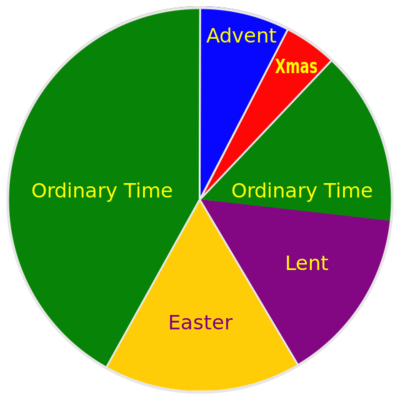Liturgical Year: Difference between revisions
Jump to navigation
Jump to search
(→Links) |
No edit summary |
||
| Line 19: | Line 19: | ||
* [[Ordinary Time]] ends with the [[Feast of Christ, the King]]. Unlike all of the other feasts of the Church year, the [[Feast of Christ, the King]] is concerned with a future event: [[Apocalypticism| the end of everything.]] | * [[Ordinary Time]] ends with the [[Feast of Christ, the King]]. Unlike all of the other feasts of the Church year, the [[Feast of Christ, the King]] is concerned with a future event: [[Apocalypticism| the end of everything.]] | ||
Before the development of the Liturgical Year, there were four times of fasting and prayer [[Ember Days|(Ember Days)]] to break the year into four quarters. | |||
== Links == | == Links == | ||
Revision as of 23:57, 15 December 2011

- The birth of the Messiah
- 6-7 weeks.
- Advent: Four Sundays prior to Christmas day.
- Christmas: December 25 to Baptism of the Lord.
- Following Jesus as a disciple
- 30-34 weeks.
- Ordinary Time: varies.
- The death and resurrection of Jesus
- 14 weeks.
The Liturgical Year also contains Holy Days of Obligation; the number varies by rite and region.
Dynamic Seasons
- The Advent season leads to Christmas day.
- The Christmas season ends with the Baptism of the Lord, the beginning of Jesus' public ministry (i.e., the time that He spent in the company of His disciples).
- Lent leads to Easter Sunday.
- The Easter season culminates on the day of Pentecost.
- Ordinary Time ends with the Feast of Christ, the King. Unlike all of the other feasts of the Church year, the Feast of Christ, the King is concerned with a future event: the end of everything.
Before the development of the Liturgical Year, there were four times of fasting and prayer (Ember Days) to break the year into four quarters.